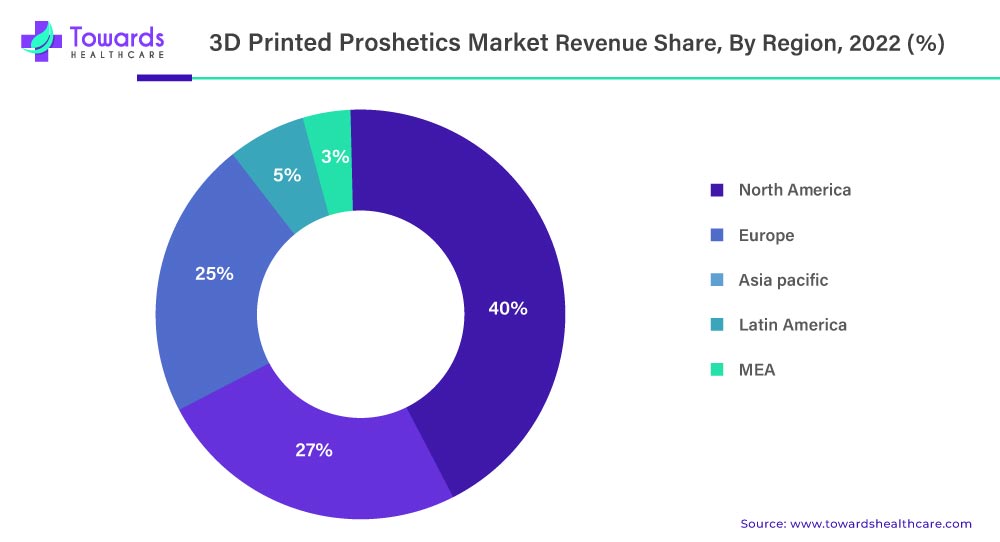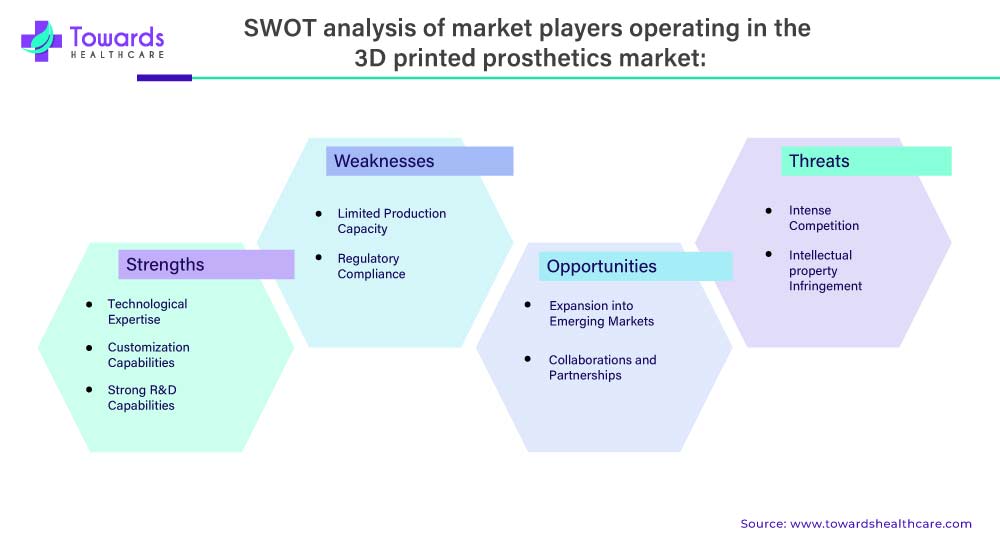The realm of prosthetics is undergoing a transformative revolution, with the global 3D printed prosthetics market poised for substantial growth. From an estimated USD 1.54 billion in 2022, the market is projected to expand at a noteworthy 7.9% CAGR (2023-2032), reaching an estimated USD 3.28 billion by 2032. This surge is attributed to the advanced benefits that 3D printed prosthetics offer over traditional counterparts.

Efforts are underway to increase the accessibility and affordability of 3D Printed Prosthetics Market in developing countries.
The 3D printed prosthetics market refers to the market for customized prosthetic devices that are created using 3D printing technology. These prosthetics are designed and manufactured based on the individual needs and specifications of patients, providing a more personalized and precise solution compared to traditional prosthetic devices. The 3D-printed prosthetics market has been growing rapidly in recent years, driven by various factors.
According to estimates by the International Society for Prosthetics and Orthotics (ISPO) and the World Health Organization (WHO), approximately 0.5% of the population in low- and middle-income countries (LMICs) require prostheses or orthotics. This percentage represents a significant portion of the population in these countries who may need assistive devices to improve their mobility and quality of life. Ensuring access to affordable and appropriate prostheses and orthotics is crucial in addressing the needs of individuals with limb loss or physical disabilities in LMICs.
The 3D printed prosthetics market is propelled by technological advancements in 3D printing, allowing for intricate designs and customization. Personalized healthcare solutions are in high demand, as patients seek prosthetics tailored to their specific needs, enhancing comfort and quality of life. The cost-effectiveness of 3D-printed prosthetics is a major driver in the market. Traditional prosthetics can be costly, but 3D printing technology offers more efficient and affordable production processes, making prosthetics accessible to a wider range of patients, including those with limited financial resources.
Role of Cost-Effectiveness Over Traditional Prosthetics in the 3D Printed Prosthetics Market
Cost-effectiveness is a significant driving factor in the 3D printed prosthetics market. 3D printing technology allows for the customization of prosthetics based on the individual needs and anatomical specifications of the patients. This eliminates the need for expensive and time-consuming manual adjustments and fittings, resulting in cost savings. 3D printing enables precise material usage, reducing waste and optimizing material costs. Unlike traditional manufacturing methods that may generate excess scrap or require large quantities of materials, 3D printing utilizes only the necessary amount, minimizing material expenses
3D printing streamlines manufacturing by eliminating the need for multiple tools, molds, and complex assembly procedures. This reduces labor costs, machinery requirements, and operational expenses, making the production of prosthetics more cost-effective. 3D printing allows for faster prosthetic production and delivery than traditional methods. The elimination of lengthy fabrication processes and the ability to produce prosthetics on demand significantly reduce lead times, enabling cost savings and improved patient satisfaction. With 3D printing, it is easier and more cost-effective to iterate and refine the design of prosthetics. This iterative approach allows for rapid prototyping, testing, and modification, leading to optimized designs and reduced development costs.
The scalability of 3D printing technology enables the efficient production of prosthetics at different volumes. Whether producing a single customized prosthetic or manufacturing in larger quantities, 3D printing can adapt to varying demand levels, resulting in cost-effective production. The cost-effectiveness of 3D printed prosthetics market can directly benefit patients by reducing the overall cost of acquiring and maintaining a prosthetic device. This affordability increases accessibility and improves the quality of life for individuals in need of prosthetic solutions. The cost-effectiveness of 3D-printed prosthetics is driving the adoption of this technology in the healthcare industry, benefiting both patients and healthcare providers by providing high-quality and affordable prosthetic solutions.
Role of Strategic Adoptions by Market Players in the 3D Printed Prosthetics Market
Strategic adoptions by market players play a crucial role in shaping the growth and development of the 3D-printed prosthetics market. These strategic initiatives enable market players to enhance their competitive position, expand their market reach, and meet the evolving needs of patients and healthcare providers.
- In July 2022, Instalimb, the world’s first 3D-printed prosthetic legs manufacturer based in Japan, secured around $ 3.3 million (approximately ₹26 crores) in Series A funding, which includes investments, loans, and grants. This funding aims to support the company’s expansion into the Indian market. Instalimb has introduced its state-of-the-art prosthetic wear solutions in Gurgaon, India, marking its entry into the Indian market
- In May 2022, UNYQ Inc., a prominent player in the 3D-printed prosthetic wear industry, introduced the UNYQ FOOT, a groundbreaking solution for creating prosthetic feet for individuals with amputations. This innovative approach leverages 3D printing technology to produce customized and functional prosthetic feet, tailored to the unique needs and preferences of each user.
- In March 2022, PPprint GmbH, a German specialist in polypropylene 3D printing solutions for professional, technical, and medical technology applications, announced a partnership with Ascent Fabrication Inc. The collaboration aims to offer premium prosthetic and orthotic digital design and central fabrication services.In
- In November 2021, Fraunhofer IGD unveiled a range of technologies that surpass the current manual production methods for individual prostheses. These advancements offer automated and more efficient processes for manufacturing personalized prosthetic devices.
- In March 2021, scientists from the Israel Institute of Technology unveiled their achievement in developing an automated production line for 3D printing low-cost customized prosthetic limbs. This technological advancement allows for the efficient and cost-effective production of personalized prosthetic limbs, making them more accessible to individuals in need.
Strategic adoptions by market players are vital in driving innovation, market expansion, and patient-centricity in the 3D-printed prosthetics market. These initiatives not only contribute to the growth and profitability of market players but also result in the development of advanced, personalized, and cost-effective prosthetic solutions for individuals with limb loss or limb impairment.
Impact of Limited Production Capacity
Limited production capacity is a restraining factor in the 3D printed prosthetics market. While 3D printing technology offers numerous advantages, including customization and cost-effectiveness, the current production capacity limitations pose challenges to its widespread adoption.
3D printing can be a time-consuming process, especially when producing complex and intricate prosthetic designs. The layer-by-layer printing method requires significant time, limiting the production output and overall capacity. The availability and capacity of 3D printing equipment can impact the production volume of prosthetics. As the demand for 3D printed prosthetics market increases, the existing equipment may not be sufficient to meet the needs, leading to production bottlenecks and limited capacity. Operating and maintaining 3D printing technology requires specialized skills and expertise. The limited availability of skilled professionals in the field of 3D printing can hinder the scaling of production capacity, further restricting the market’s growth.
The availability of suitable materials for 3D printing prosthetics can impact production capacity. Ensuring a consistent supply of high-quality materials that meet the required standards and specifications is crucial for scaling up production and meeting market demands. Regulatory processes and certifications for 3D printed prosthetics market can add complexity and time to the production cycle. Compliance with safety and quality standards, as well as obtaining necessary approvals, may slow down production and limit the overall capacity.
Addressing the limited production capacity is essential to unlock the full potential of the 3D-printed prosthetics market. Investment in advanced 3D printing technologies, expansion of production facilities, development of more efficient printing processes, and training programs to enhance the skills of the workforce can help overcome this restraint and increase the market’s capacity to meet the growing demand for 3D printed prosthetics market.
Regional Landscape of 3D Printed Prosthetics Market
North America, particularly the United States, is a significant region in the 3D printed prosthetics market. The United States has a well-established healthcare infrastructure, advanced technological capabilities, and a high prevalence of limb loss and limb impairment cases. These factors contribute to the strong demand for 3D printed prosthetics market in the country.
In the United States, there is a growing emphasis on personalized healthcare and patient-centric approaches. This trend aligns well with the capabilities of 3D printing technology, which allows for the customization and personalization of prosthetic devices. The ability to create prosthetics tailored to an individual’s unique anatomical and functional needs is a key driving factor in the adoption of 3D printed prosthetics market in the United States. According to the Amputee Coalition, the United States has a significant number of people living with limb loss, with nearly 2 million individuals affected and 28 million people are at risk of needing amputation surgery.
Each year, approximately 185,000 amputations take place in the country due to various causes, including vascular disease and trauma. These numbers highlight the prevalence of limb loss and the ongoing need for effective healthcare services, rehabilitation, and support for individuals living with limb loss in the United States.

The Asia Pacific region is emerging as a significant market for 3D-printed prosthetics. Factors such as the large population, increasing healthcare expenditure, and a rising prevalence of limb impairments and disabilities contribute to the growth of the market in this region. Countries like China, Japan, India, and South Korea are at the forefront of the adoption of 3D-printed prosthetics in the Asia-Pacific region.
Unveiling the Dynamics of Growth
Superior Advantages Propel Market Expansion
The exponential growth of the 3D printed prosthetics market is propelled by the inherent advantages it holds over traditional prosthetic solutions. From enhanced customization to improved comfort and functionality, 3D printing technology is reshaping the landscape of prosthetic devices.
A Glimpse into the CAGR Trajectory
Projections indicate a robust compound annual growth rate (CAGR) of 7.9% for the period from 2023 to 2032. This trajectory reflects the increasing acceptance and adoption of 3D printed prosthetics market as a preferred choice for amputees worldwide.
Key Drivers Steering the Phenomenal Rise
Technological Innovations Redefining Prosthetic Design
The integration of cutting-edge technologies in 3D printing is revolutionizing prosthetic design. Customized, anatomically accurate prosthetics are becoming more accessible, offering users a level of comfort and mobility that was previously unimaginable.
Surge in Awareness Fuels Adoption
As awareness about the benefits of 3D printed prosthetics market spreads, there is a significant surge in adoption. The global community is recognizing the potential to enhance the quality of life for individuals with limb loss, driving the demand for these innovative solutions.
Challenges and Opportunities on the Horizon
Overcoming Cost Barriers
While the advantages are evident, cost barriers remain a challenge to widespread adoption. However, ongoing research and development efforts aim to address these barriers, making 3D printed prosthetics market more accessible to a broader demographic.
Opportunities in Research and Collaboration
The future holds promising opportunities for research and collaboration. Industry players, healthcare professionals, and technology experts collaborating can propel further innovations, making 3D printed prosthetics an integral part of mainstream healthcare.
Customization and Personalization Presents Massive Opportunities
Customization and personalization offer significant opportunities in the 3D-printed prosthetics market. One of the key advantages is the ability to provide patient-specific solutions. With 3D printing technology, prosthetics can be customized to fit the unique needs and specifications of individual patients. Precise measurements and anatomical data can be captured to create prosthetics that perfectly align with the patient’s body shape, size, and functional requirements. This level of customization enhances comfort, functionality, and overall satisfaction for the wearer.
In addition, customization enables the optimization of prosthetic performance. By tailoring the shape, alignment, and components of the prosthetic, 3D printing allows for improved functionality, enhanced mobility, and better integration with the wearer’s body. This level of customization ensures that the prosthetic meets the specific needs of each patient, leading to better outcomes and a higher quality of life. In addition to functional benefits, customization and personalization also offer aesthetic advantages. 3D printing technology allows for the creation of prosthetics with intricate and visually appealing designs.
Furthermore, customized prosthetics can be personalized with colors, patterns, and textures to match the wearer’s preferences and enhance self-expression. This aspect is particularly important for prosthetics worn in visible areas, such as hands and arms, as it allows individuals to showcase their personality and individuality. Another opportunity lies in the rapid prototyping and iterative design capabilities of 3D printing. With this technology, prosthetists and designers can quickly create and refine prototypes based on patient feedback. The iterative design process enables faster modifications and improvements, resulting in a more precise and functional final product. This agility in design helps to address individual patient needs more efficiently and effectively.
Moreover, customization and personalization are essential for meeting the unique needs of certain patient populations. Children and individuals with complex anatomical or functional challenges require specialized prosthetic solutions. 3D printing technology allows for the development of adaptive prosthetics that can be customized to address these unique needs. By providing tailored solutions, 3D printed prosthetics market can promote better outcomes and improve the quality of life for these individuals. Customization and personalization offer a means for market differentiation and competitive advantage. Companies that can offer customized and personalized prosthetics can differentiate themselves in the market and attract more customers. The ability to provide tailored solutions that meet the specific needs and preferences of patients fosters brand loyalty and drives business growth.
To fully leverage the opportunities of customization and personalization in the 3D printed prosthetics market, stakeholders should invest in advanced design software, scanning technologies, and 3D printing capabilities. Collaboration between prosthetists, designers, engineers, and patients is crucial to ensure the development of truly personalized solutions that address the unique requirements and preferences of each individual.

Strengths:
- Market players with strong expertise in 3D printing technology have an advantage in developing and producing high-quality 3D printed prosthetics market.
- Companies with advanced customization capabilities can offer personalized prosthetics that cater to patients’ specific needs and preferences.
- Market players investing in research and development can stay at the forefront of technological advancements and continuously improve their product offerings.
Weaknesses:
- Some market players may face challenges in scaling up their production capacity to meet the increasing demand for 3D-printed prosthetics.
- Compliance with evolving regulations and quality standards for medical devices can be a challenge, especially for smaller companies entering the market.
Opportunities:
- Market players can explore opportunities in emerging markets where the adoption of 3D-printed prosthetics is still growing, offering untapped market potential.
- Collaborating with healthcare providers, research institutions, and other industry players can lead to knowledge sharing, innovation, and the development of new and improved prosthetic solutions.
- Expanding the product portfolio to include a wider range of 3D printed prosthetics market for different anatomical areas and applications can cater to a broader customer base.
Threats:
- The 3D printed prosthetics market is becoming increasingly competitive, with the entry of new players and established companies expanding their offerings. This can lead to price pressures and a challenging market landscape.
- Protecting intellectual property rights and preventing unauthorized use or replication of innovative 3D printing technologies and designs is crucial to mitigate the risk of infringement.
Competitive Landscape:
The competitive landscape of the 3D printed prosthetics market is characterized by a mix of established players and emerging companies. The market is relatively fragmented, with numerous players operating at various scales. The market players represent a diverse range of organizations, including medical device manufacturers, prosthetic solution providers, research institutions, and start-ups specializing in 3D printing technologies. Market players adopt various strategies to establish their presence and gain a competitive edge.
These strategies include product innovation, partnerships, collaborations, acquisitions, and geographic expansion. Many companies are focused on advancing the capabilities of 3D printed prosthetics market by integrating new materials, improving design software, and enhancing manufacturing processes. Product differentiation through unique features and functionalities is a common strategy to attract customers and create a niche in the market.
Major players in 3D printed prosthetics market are 3D Systems Corporation, EnvisionTEC, Stratasys Ltd., Bionicohand, YouBionic, UNYQ, Mecuris, LimbForge, Inc., Open Bionics, Create Prosthetics, Bio3D Technologies, Laser GmbH, Prodways Group, Protosthetics, 3T RPD Ltd., and Formlabs.
Market Segmentation:
By Type
- Sockets
- Limbs
- Joints
- Others
By Material
- Polyethylene
- Polypropylene
- Acrylics
- Polyurethane
By End-use
- Hospitals
- Rehabilitation Centers
- Prosthetic Clinics
By Geography
- North America
- Europe
- Asia-Pacific
- Latin America
- Middle East and Africa
Conclusion: Transforming Lives with 3D Printed Prosthetics Market
In conclusion, the global 3D printed prosthetics market is not just witnessing growth; it is reshaping the very essence of prosthetic solutions. With an estimated value of USD 3.28 billion by 2032, 3D printed prosthetics are at the forefront of providing enhanced mobility, comfort, and customization. As we look to the future, challenges will be met with innovation, and the opportunities for collaboration will continue to drive the evolution of this transformative market.



